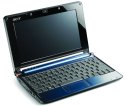Acer leads hot netbook market
Dec 8, 2008 — by Eric Brown — from the LinuxDevices Archive — 2 views The netbook category grew at a quarter-to-quarter rate of more than 160 percent in the third quarter, and Acer bypassed Asus as the top vendor, says a DisplaySearch study. Meanwhile, an ABI Research “Vendor Matrix” report finds Intel holding pole position among netbook processor vendors.
The netbook category grew at a quarter-to-quarter rate of more than 160 percent in the third quarter, and Acer bypassed Asus as the top vendor, says a DisplaySearch study. Meanwhile, an ABI Research “Vendor Matrix” report finds Intel holding pole position among netbook processor vendors.
(Click for larger view of Acer's Aspire One)
The hot market for netbooks, also known as “mini-notes,” is flying in the face of what looks to be a “dismal fourth quarter for the PC industry,” says DisplaySearch in its latest “Quarterly Notebook PC Shipment and Forecast Report.” The netbook market grew from less than one million units sold in 2007 to a projected 14 million units sold by the end of 2008. Although operating system (OS) share is not detailed in the DisplaySearch report, Linux may be shipping on about a quarter of all netbooks (see farther below for more details).
Most of the top-tier PC brands have now entered the market, putting pressure on early netbook entrants, says the research group. Asus, which “essentially created the market” in late 2007 with its Eee PC netbooks, fell from its dominant position to a close second place position at 30.3 percent share in the third quarter, says DisplaySearch. Acer, meanwhile, surged to a leading 35 percent share with its Acer Aspire One netbook (pictured at top), which sold 2.15 million units in the third quarter alone, according to the study.
 HP's Mini 1000 offers a homegrown Linux distro (Click for details) |
The third- and fourth-ranked netbook vendors trail far behind at under six percent each. Third-place HP, which leads the overall notebook market, according to the study, introduced one of the first of the second wave of netbooks with its HP 2133 Mini-Note PC. HP recently announced an HP Mini 1000 netbook (pictured) that offers media-centric Linux distribution called MIE (Mobile Internet Experience). MSI, meanwhile, comes in fourth with its Wind NB U100 netbook.
Dell, which sells an Inspiron Mini 12 netbook, barely inches out Medion, as well as the OLPC (One Laptop per Child) and its education-oriented XO for the next three slots. Germany-based Medion sells its Akoya Mini E1210 netbook, a version of the MSI Wind NB U100 that runs Windows XP only, but the other top models, including MSI's version of the Wind netbook, all offer a choice of Linux or Windows XP, running on an Intel Atom processor.
Third-quarter market share percentages for the netbook category are said to be:
- Acer — 38.3
- Asus — 30.3
- HP — 5.8
- MSI — 5.7
- Dell — 2.8
- OLPC — 2.3
- Medion — 2.3
- Kohjinsha — 1.0
- Intel — 1.0
- Lenovo — 0.7
- Toshiba — 0.5
- All others — 9.1
The DisplaySearch study breaks down the notebook and netbook market by factors including size, price, aspect ratio, and region, but it does not appear to analyze OS share. A recent Bloomberg.com story reported that Acer and Asus run Linux on about 30 percent of their netbooks, and it quotes Microsoft has saying that about 70 percent of all netbooks run Windows. Given these numbers, and the almost exclusive domination of the segment by Windows XP and Linux, if appears that Linux is likely to represent over a quarter of the market, far more than its share of the overall PC market, which was recently pegged at less than one percent.
The Bloomberg.com story reported an Acer claim that its Aspire One had overtaken Asus in the third quarter. The report also cites a Citigroup study as saying that netbooks will represent “about a third” of PC growth in 2008, and will grow at an annual rate of 60 percent through 2010, when Citigroup expects 29 million netbooks to sell.
ABI: Intel ranks high in Vendor Matrix
ABI Research has ranked Intel at the top of its latest “Vendor Matrix” evaluation of netbook platform vendors. Texas Instruments (TI) and Via Technologies were ranked second and third. Intel dominates the market with its Intel Atom processors.
With the Vendor Matrix analytical tool, the research group assesses vendors on “innovation” and “implementation” across several criteria. For “innovation,” the research group examined speed to market, design flexibility, support for 720p HD video, bundling of WWAN, WPAN and/or GPS, and the use of x86 or Cortex A-8 (or higher) processors, says ABI Research. Under “implementation,” the vendors were rated on announced design wins, experience with CE and mobile device vendors, experience with PC vendors, support for multiple PC operating systems, and support for lower level operating systems.
Stated ABI Research principal analyst Philip Solis, “X86-based solutions allow netbook vendors the flexibility to create one product with the option to run Linux or Windows. However, we expect ARM-based vendors to become more competitive here as netbooks evolve to be much lighter, thinner, and cheaper with longer battery life, and as consumers come to accept Linux OSs more readily.”
ARM's director of mobile solutions, Rob Coombs, reportedly told ZDNet UK in October to expect announcements of Cortex-A8 netbooks “in the next few months.”
Availability
The DisplaySearch report, “Quarterly Notebook PC Shipment and Forecast Report,” may be found here. ABI Research's “Netbook Platform Vendor Matrix” should be here, with free registration required for the complete report.
This article was originally published on LinuxDevices.com and has been donated to the open source community by QuinStreet Inc. Please visit LinuxToday.com for up-to-date news and articles about Linux and open source.